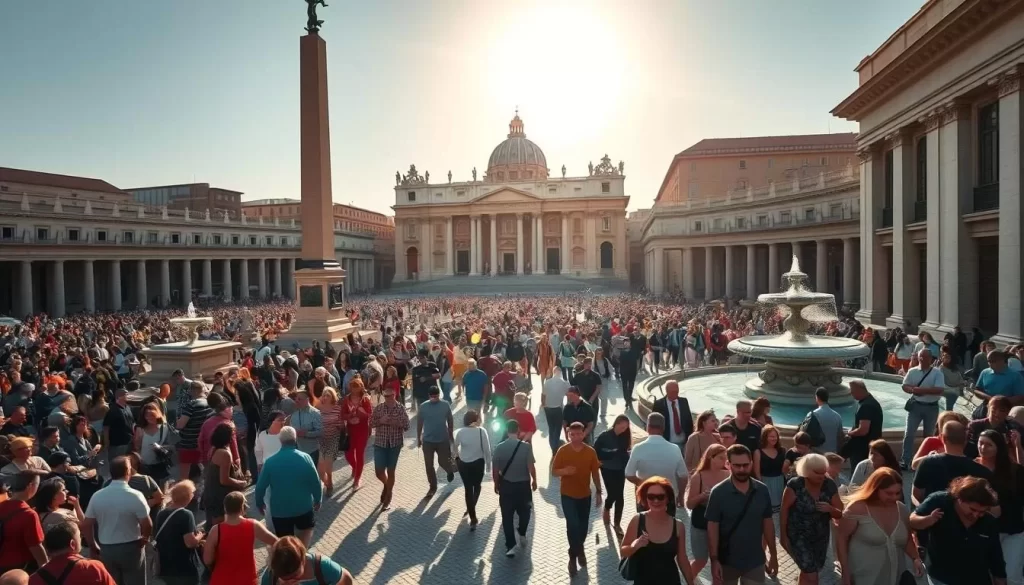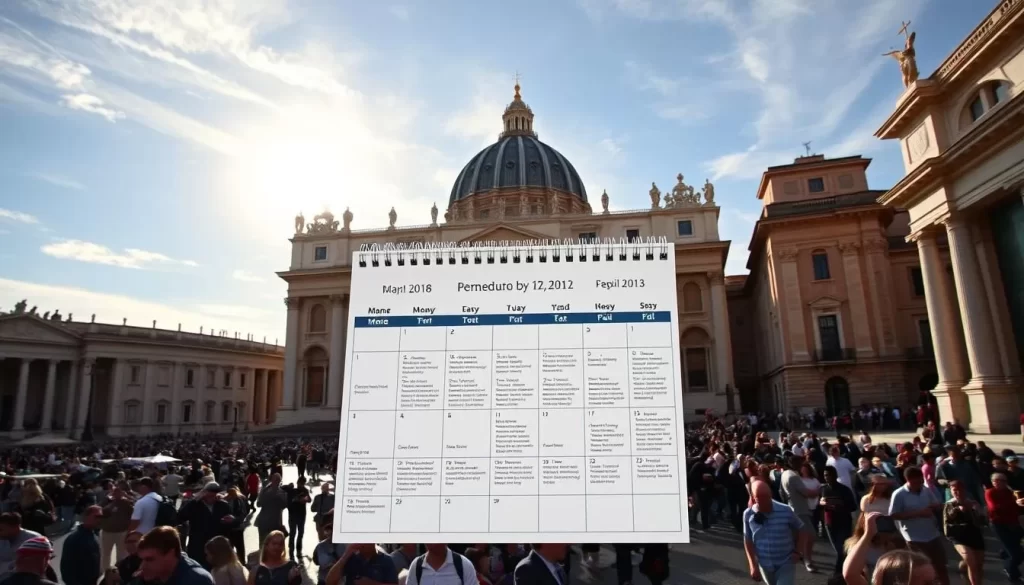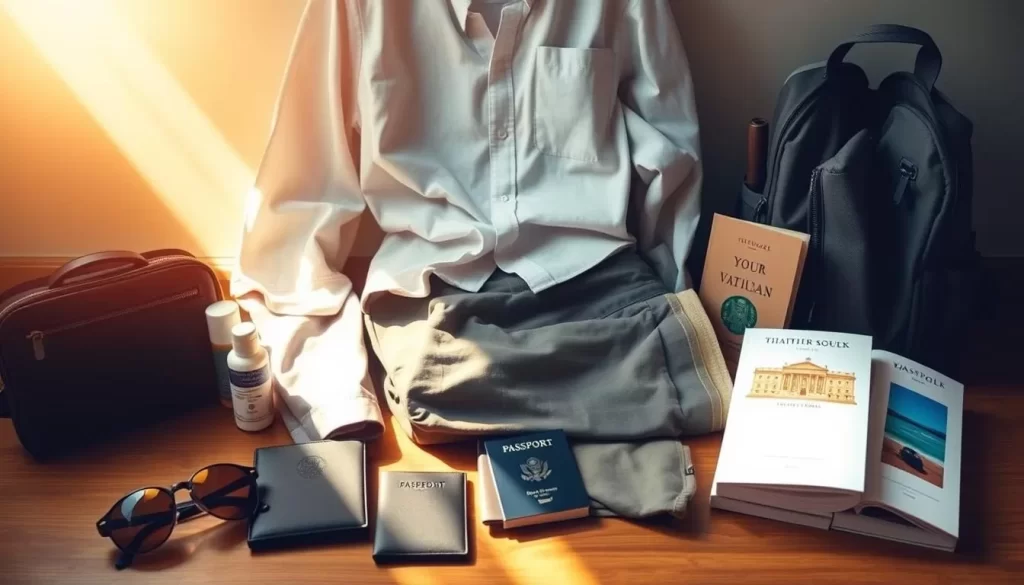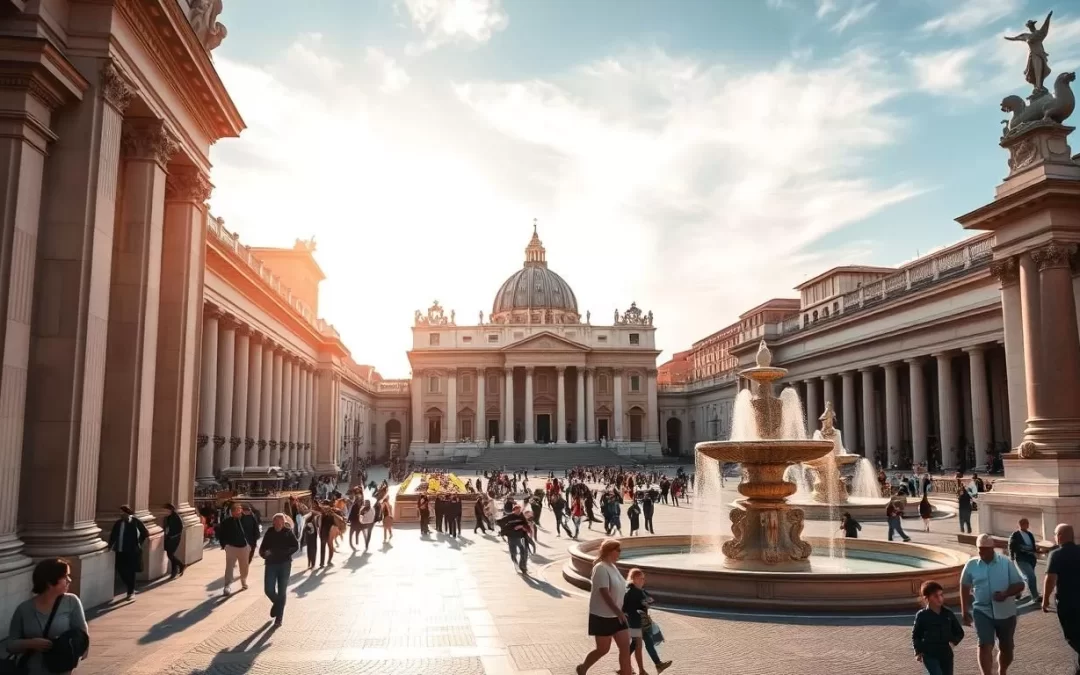When you’re planning to visit the Eternal City, understanding the best time to visit can make all the difference in your travel experience. Rome, the city that houses the Vatican, is a year-round destination, but certain periods are more conducive to exploration than others.
The weather plays a significant role in determining the quality of your trip. Spring and Autumn are generally considered ideal due to their mild climate and fewer crowds.
To ensure a rewarding experience, it’s crucial to consider factors like crowd levels and special events when planning your visit. By doing so, you can maximize your sightseeing opportunities and enjoy a more relaxed pace.
Understanding Vatican City’s Climate
Vatican City experiences a Mediterranean climate, similar to Rome, with its characteristic hot summers and mild winters. This climate type significantly influences the weather conditions throughout the year, making some seasons more favorable for visiting than others.
Mediterranean Weather Patterns
The Mediterranean climate is characterized by hot, dry summer months and mild, wet winter months. During the summer, temperatures can soar above 90°F (32°C), while in winter
How Vatican’s Microclimate Differs from Rome
Although Vatican City is within Rome, its microclimate differs due to its higher elevation and more open spaces. This results in slightly different conditions that can affect your visit. For instance, the stone buildings and expansive St. Peter’s Square can amplify the heat during summer, making morning visits preferable.
| Season | Weather Conditions | Best Time to Visit |
|---|---|---|
| Spring | Mild temperatures, moderate rainfall | March to May |
| Summer | Hot, dry | June to August (morning visits) |
| Autumn | Comfortable temperatures, moderate rainfall | September to November |
| Winter | Cool, occasional rain | December to February |
Vatican: Best Months for a Weather-Savvy Trip
To make the most of your visit to the Vatican, understanding the best times to go is crucial. The Vatican City, being an independent city-state within Rome, shares a similar climate with its surroundings, making certain periods more ideal for visiting than others.
Spring (March-May): Perfect Balance
Spring is a delightful time to visit the Vatican. The weather is mild, with temperatures ranging from 65-75°F (18-24°C), making it ideal for exploring the Vatican’s vast grounds and attractions. The gardens are in bloom, adding to the beauty of the surroundings. April and May are particularly pleasant, with manageable crowd levels before the peak summer season.
Fall (September-November): Ideal Temperatures
Fall is another excellent season to visit the Vatican. The temperatures are pleasant, and the summer crowds have dissipated, making it a more relaxed experience. The golden light of autumn adds a picturesque quality to the Vatican’s architecture and gardens. September through early November is a great time to enjoy the Vatican’s attractions without the intense summer heat.
Avoiding Summer Heat and Winter Chill
While summer might seem like a good time to visit due to school vacations, the heat and massive crowds can make it a challenging experience. July and August are particularly hot, with temperatures often exceeding 90°F (32°C). On the other hand, winters can be cool and rainy, though the fewer tourists might be an advantage for some visitors. Major religious holidays like Christmas can still attract significant crowds.
![]()
Here’s a summary of the best times to visit the Vatican, considering the factors of weather and crowds:
| Season | Months | Weather | Crowds |
|---|---|---|---|
| Spring | March-May | Mild, 65-75°F (18-24°C) | Manageable |
| Fall | September-November | Pleasant | Gradually thinning |
| Summer | June-August | Hot, often over 90°F (32°C) | Massive |
| Winter | December-February | Cool, rainy | Fewer, except during holidays |
By planning your visit during the spring or fall, you can enjoy a more balanced experience, with comfortable weather and reasonable crowd levels. Whether you’re looking to explore the Sistine Chapel, St. Peter’s Basilica, or the Vatican Gardens, timing your trip right can make all the difference.
Seasonal Breakdown: What to Expect Year-Round
The Vatican’s climate varies significantly throughout the year, affecting your travel experience. Understanding these seasonal changes can help you prepare for your visit.
Winter in Vatican City
Winter, spanning from December to February, brings cooler temperatures, averaging 45-55°F (7-13°C) during the day, and occasional rainfall. However, this season offers the advantage of significantly reduced crowds, except during Christmas and New Year celebrations.
Spring Awakening
Spring, from March to May, transforms the Vatican with warming temperatures, blooming gardens, and increasing daylight hours, creating ideal conditions for exploring both indoor and outdoor attractions.
Summer Heat
Summer months, June through August, deliver long, hot days with temperatures often exceeding 90°F (32°C), bringing peak tourist season with massive crowds and lengthy waiting times at all Vatican sites.
Fall Tranquility
Fall, from September to November, offers a gradual cooling from the summer heat, with pleasant days, cooler evenings, and decreasing crowd levels as the season progresses.
| Season | Weather | Crowd Levels |
|---|---|---|
| Winter (Dec-Feb) | Cooler, occasional rain | Low, except during holidays |
| Spring (Mar-May) | Mild, blooming gardens | Moderate |
| Summer (Jun-Aug) | Hot | High |
| Fall (Sep-Nov) | Pleasant days, cool evenings | Moderate to low |
Each season presents distinct lighting conditions that can affect your experience and photography of Vatican attractions. Understanding these patterns allows you to prepare appropriately for your visit.
Peak vs. Off-Peak: Balancing Weather and Crowds
When planning your trip to Vatican City, understanding the balance between weather and crowds is crucial for a memorable experience. The city’s popularity among tourists means that the time of year you visit can significantly impact your overall experience.
High Season Challenges
The peak season, which includes June, July, and August, brings the most challenging crowd conditions to Vatican City. During this time, waiting times for the Vatican Museums can exceed 2-3 hours without advance reservations. You’ll encounter the highest concentration of tourist groups, making it difficult to fully appreciate the details and atmosphere of popular sites like the Sistine Chapel.

Sweet Spot Months
The sweet spot months, April-May and September-October, offer the best balance between comfortable weather and manageable crowd levels, making them ideal for most visitors. During these shoulder seasons, you’ll still need to plan ahead, but waiting times are significantly reduced, and the overall experience feels less rushed and more enjoyable.
Benefits of Low Season Travel
Traveling during the low season, November-March, has its benefits, including dramatically reduced crowds, except during Christmas and Easter periods. This allows for a more contemplative experience of Vatican treasures. Winter visitors often report being able to spend more time appreciating art details in the Sistine Chapel and Vatican Museums due to reduced crowd pressure.
| Season | Crowd Level | Weather |
|---|---|---|
| Peak Season (June-August) | High | Warm |
| Shoulder Season (April-May, September-October) | Moderate | Mild |
| Low Season (November-March) | Low | Cool |
Understanding these crowd patterns helps you make informed decisions about when to visit based on your tolerance for crowds versus your weather preferences. It’s also advisable to check the Papal calendar before planning your trip, as special religious events can create temporary crowd surges even during otherwise quiet periods.
Month-by-Month Vatican Weather Guide
To make the most of your Vatican visit, it’s essential to understand the monthly weather patterns. The Vatican’s climate, much like Rome’s, varies significantly throughout the year, influencing the best times to visit its iconic attractions.
January-March: Winter into Spring
January is the chilliest month, with temperatures ranging from 40-55°F (4-13°C), occasional rain, and shorter daylight hours. However, it’s a great time to visit if you prefer fewer crowds. February continues the winter pattern but with gradually increasing daylight, making some days pleasant for exploring St. Peter’s Square. March is a transition month with unpredictable weather, requiring flexible planning and layered clothing.
April-June: Spring into Summer
April marks the beginning of ideal visiting conditions, with warming temperatures (55-70°F/13-21°C), blooming gardens, and longer daylight hours. May offers near-perfect conditions, with warm days and mild evenings, making it ideal for visiting the Vatican Gardens. June begins the summer season with longer days and increasing temperatures (70-85°F/21-29°C), but be prepared for growing crowds.
July-September: Summer into Fall
July and August are the hottest months (85-95°F/29-35°C), making morning or evening visits preferable for outdoor attractions. September begins the gradual cooling process, maintaining summer-like conditions early in the month before transitioning to more comfortable temperatures.
October-December: Fall into Winter
October offers ideal fall conditions with pleasant days, cooler evenings, and decreasing crowd levels. November brings increased chances of rain and cooler temperatures (50-65°F/10-18°C), but with significantly reduced crowds. December features winter conditions, with holiday decorations and special religious celebrations creating a unique atmosphere.
| Month | Temperature Range (°F) | Weather Conditions |
|---|---|---|
| January | 40-55 | Cold, occasional rain |
| April | 55-70 | Mild, blooming gardens |
| July | 85-95 | Hot, intense midday heat |
| October | 60-75 | Pleasant, fewer crowds |
Understanding these monthly variations can help you plan a more enjoyable and stress-free trip to the Vatican, ensuring that you make the most of your visit regardless of the time of year you choose to go.
Vatican’s Special Events Calendar
Understanding the Vatican’s special events calendar is crucial for making the most of your visit, whether you’re interested in religious ceremonies or cultural exhibitions. The Vatican City hosts numerous significant events and celebrations throughout the year, which can impact your experience.
Religious Celebrations and Papal Events
The Vatican’s religious calendar significantly influences visitor experiences, with major celebrations like Easter and Christmas drawing thousands to St. Peter’s Square and Basilica.Holy Week, the week before Easter, is particularly busy, with special Masses and the Via Crucis procession on Good Friday, attracting over 100,000 people. Regular Papal audiences on Wednesdays when the Pope is in residence also draw large crowds.
- Easter and Christmas are peak periods for religious celebrations.
- Holy Week includes special Masses and the Via Crucis procession.
- Papal audiences occur on Wednesdays, affecting access to other attractions.
Seasonal Museum Exhibitions
The Vatican Museums host rotating special exhibitions that can influence visitor numbers and create focused interest in particular collections or themes. These exhibitions are an essential part of the Vatican’s cultural calendar.
How Weather Impacts Vatican Events
Weather conditions directly impact outdoor Vatican events. Summer heat can cause schedule adjustments for Papal audiences, while winter celebrations like Christmas Eve Midnight Mass require advance planning.

By understanding the Vatican’s events calendar, you can plan your visit to either avoid or participate in these significant events, enhancing your overall experience.
Insider Tips for Weather-Based Planning
Planning your Vatican visit around the weather can significantly enhance your experience. The Vatican’s attractions are best enjoyed when you plan your visit around the weather.
Best Times for Outdoor Vatican Gardens Tours
For an optimal Vatican Gardens tour experience, consider visiting early in the morning. Early morning tours (8:00-9:00 AM) offer cooler temperatures, beautiful morning light, and fewer visitors. It’s essential to book these tours in advance as they sell out quickly, especially during peak season.
Optimal Hours for St. Peter’s Square Visits
To make the most of your visit to St. Peter’s Square, plan your trip during the early morning or late afternoon hours. This timing helps you avoid the midday heat in summer and the largest tour groups that typically arrive mid-morning.
Weather-Smart Sistine Chapel Strategies
The Sistine Chapel is a must-visit attraction, but it can get crowded. To avoid the crowds, consider visiting during the early morning when the Vatican Museums open at 9:00 AM, or plan a late afternoon visit after 3:00 PM. Booking “early access” tours can also be beneficial during peak season.
Understanding the best times to visit Vatican attractions can make a significant difference in your overall experience. Here are some key tips to keep in mind:
- Visit the Vatican Gardens early in the morning for a more serene experience.
- Plan your St. Peter’s Square visit during early morning or late afternoon.
- Beat the crowds at the Sistine Chapel by visiting early in the morning or late in the afternoon.
- Consider the weather when planning your visit, as it can impact waiting times and overall comfort.
What to Pack for Your Vatican Visit
When planning your trip to the Vatican, it’s essential to pack wisely to ensure a comfortable and enjoyable experience. The Vatican’s unique blend of art, history, and spirituality requires a thoughtful approach to what you bring along.
Seasonal Clothing Essentials
The time of year you visit the Vatican significantly influences what you should pack. For summer visits (June-August), lightweight, breathable clothing is a must, while still adhering to the Vatican’s modesty requirements. In contrast, winter visitors (December-February) should pack layers, including a warm jacket and scarf, for exploring outdoor areas like St. Peter’s Square.
For spring and fall, versatile clothing that can adapt to changing temperatures is ideal. Comfortable walking shoes are a year-round necessity due to the extensive walking involved in Vatican tours.
Vatican Dress Code Considerations
The Vatican has a strict dress code for visiting sites like St. Peter’s Basilica, the Sistine Chapel, and Vatican Museums. This means covering your shoulders and knees, regardless of the weather. A light scarf can be a useful item to carry for this purpose.
Weather Protection Must-Haves
Given that the rainy season in Rome extends from October to April, it’s wise to pack rain protection, such as a compact umbrella or light raincoat. Additionally, a small daypack can be handy for carrying essentials like water, sun protection, and extra layers while keeping your hands free for photography.

Budget Considerations Across Seasons
When considering a visit to the Vatican, understanding how seasonal changes impact your budget is crucial. The cost of your trip can vary significantly depending on the time of year you choose to visit.
Seasonal Price Fluctuations
Accommodation prices near the Vatican fluctuate dramatically throughout the year. Peak season, which includes June through August, sees rates that are often 30-50% higher than those during the low season, from November to February, for the same rooms. This significant difference can greatly impact your overall travel budget.
- Visiting during the shoulder seasons (April-May and September-October) can offer the best value, with pleasant weather and lower prices compared to the summer highs.
- The lowest prices are typically available in January and February, excluding Valentine’s Day weekend, making these months ideal for travelers on a budget who can tolerate cooler temperatures.
- Vatican Museums entrance fees remain consistent year-round, but specialized tours and experiences often come with discounted rates during periods of lower demand.
Best Value Months for Vatican Trips
To maximize your budget, consider visiting during the shoulder season. Not only are accommodations more affordable, but you’re also likely to encounter fewer tourists, making for a more enjoyable experience.
Advance Planning is key to saving on your Vatican visit. Booking your accommodations well in advance (3-6 months prior) for peak season visits can result in significant savings. Conversely, taking advantage of last-minute deals during the low season can also be beneficial.
Saving on Accommodations Near Vatican City
For better accommodation values, consider staying in neighborhoods slightly further from the Vatican, such as Prati or Aurelio. These areas still offer easy access to major attractions while being more budget-friendly.
Additionally, restaurant prices near major Vatican attractions tend to remain relatively stable year-round, but you’ll find more special offers and fixed-price menus during lower tourist seasons, which can be a great way to save on dining expenses.
Transportation costs to and from Rome also fluctuate, with summer flights commanding premium prices. In contrast, winter travel, excluding Christmas and New Year’s periods, offers the best airfare values, making it an attractive option for those looking to save on travel expenses.
Conclusion: Planning Your Weather-Perfect Vatican Experience
Your Vatican experience can be significantly enhanced by choosing the right time to visit, balancing weather and crowd considerations. The ideal Vatican experience combines comfortable weather conditions with manageable crowd levels, making spring (April-May) and fall (September-October) the most universally appealing times to visit.
Regardless of when you visit, strategic timing of your day can dramatically improve your experience. For instance, early mornings at St. Peter’s Basilica and late afternoons at the Vatican Museums can help you avoid the crowds. Additionally, day trips can be planned around the weather forecasts to ensure a smooth visit.
To make the most of your visit, consider the following:
– Plan your trip during the shoulder season (April-May, September-October) for better weather and fewer crowds.
– Make the most of your day by visiting popular attractions like St. Peter’s Basilica early in the morning.
– Be prepared for your visit by checking the weather forecast and dressing accordingly.
By balancing weather forecasts, crowd calendars, and personal preferences, you can craft a Vatican visit that perfectly aligns with your travel style and creates lasting memories of this extraordinary place. Whether you’re visiting the Vatican Museums or taking a stroll around St. Peter’s Square, your experience will be enriched by thoughtful planning.
The above is subject to change.
Check back often to TRAVEL.COM for the latest travel tips and deals.
Here are some Tours & Sightseeing suggestions that might pique your interests!
